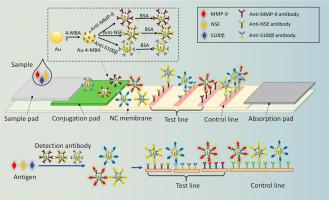Applied Surface Science ( IF 6.3 ) Pub Date : 2021-09-13 , DOI: 10.1016/j.apsusc.2021.151153 Yanan Song 1, 2 , Jingyi Sun 3 , Shijun Zhao 4 , Feng Gao 2 , Hui Yuan 1 , Baoliang Sun 1, 2 , Baojun Wang 4 , Ying Wang 2

|
Despite optimistic trends in mortality and incidence, stroke is still a major cause of disability and death in populations. The application of blood-based biomarkers is known as a promising field for predicting the disease severity and prognosis to further guide therapy strategy. However, proposing a method that can accurately and sensitively identify patients by biomarkers detection remains a notable challenge due to the complexity of stroke pathogenesis and low abundance of target molecules. In this experiment, we designed a target antibody modified surface-enhanced Raman scattering (SERS) active nanospheres (GNPs) combined with probe-immobilized lateral flow strip as nanostructure to assess multiple-biomarker in blood samples of stroke patients simultaneously. Then the sensitive and quantitative measures toward stroke-related matrix metalloproteinase-9 (MMP-9), S100 calcium-binding protein B protein (S100-β), and neuro-specific enolase (NSE) were implemented in a wide range from 0.0001 ng/mL to 1000 ng/mL and a limit of detection of 0.01 pg/mL. Furthermore, the accuracy of SERS imaging was detected by enzyme linked immunosorbent assay (ELISA); the outcome obtained through SERS imaging was in accord with those obtained by ELISA. Therefore, this method can provide a reliable strategy for stroke diagnosis and prognosis evaluation with showing great prospect for clinical applications through further quantitative analysis of molecules in blood samples.
中文翻译:

基于侧流免疫传感器的超灵敏和选择性表面增强拉曼光谱中风生物标志物检测
尽管死亡率和发病率呈乐观趋势,但中风仍然是导致人群残疾和死亡的主要原因。基于血液的生物标志物的应用被认为是预测疾病严重程度和预后以进一步指导治疗策略的有前途的领域。然而,由于中风发病机制的复杂性和靶分子的低丰度,提出一种能够通过生物标志物检测准确、灵敏地识别患者的方法仍然是一个显着的挑战。在本实验中,我们设计了一种目标抗体修饰的表面增强拉曼散射 (SERS) 活性纳米球 (GNP),结合探针固定的横向流动条作为纳米结构,同时评估中风患者血液样本中的多种生物标志物。然后对中风相关基质金属蛋白酶-9 (MMP-9)、S100 钙结合蛋白 B 蛋白 (S100-β) 和神经特异性烯醇化酶 (NSE) 的敏感和定量测量在 0.0001 ng 的广泛范围内实施/mL 至 1000 ng/mL,检测限为 0.01 pg/mL。此外,通过酶联免疫吸附试验(ELISA)检测SERS成像的准确性;SERS成像结果与ELISA结果一致。因此,该方法可以为脑卒中的诊断和预后评估提供可靠的策略,通过进一步对血样中的分子进行定量分析,具有广阔的临床应用前景。0001 ng/mL 至 1000 ng/mL,检测限为 0.01 pg/mL。此外,通过酶联免疫吸附试验(ELISA)检测SERS成像的准确性;SERS成像结果与ELISA结果一致。因此,该方法可以为脑卒中的诊断和预后评估提供可靠的策略,通过进一步对血样中的分子进行定量分析,具有广阔的临床应用前景。0001 ng/mL 至 1000 ng/mL,检测限为 0.01 pg/mL。此外,通过酶联免疫吸附试验(ELISA)检测SERS成像的准确性;SERS成像结果与ELISA结果一致。因此,该方法可以为脑卒中的诊断和预后评估提供可靠的策略,通过进一步对血样中的分子进行定量分析,具有广阔的临床应用前景。









































 京公网安备 11010802027423号
京公网安备 11010802027423号